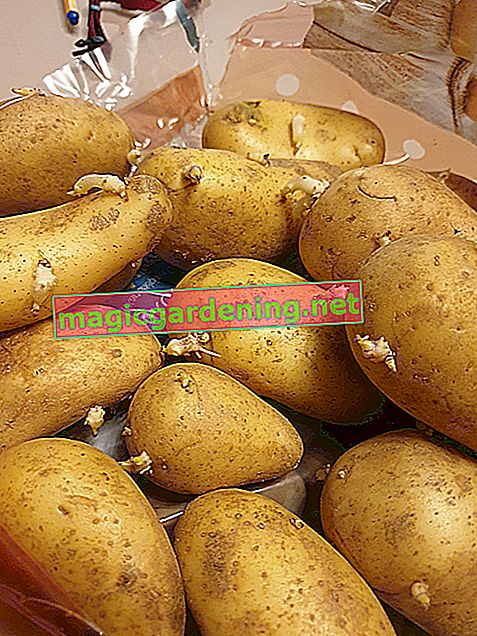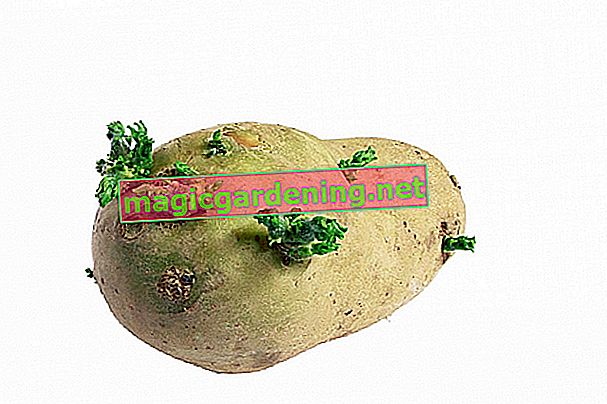
the essentials in brief
- Green potatoes are high in poisonous solanine
- While tasting green potatoes is unlikely to have any effect, consuming larger amounts can lead to symptoms of intoxication
- Signs of poisoning include: scratchy throat, headache, gastrointestinal complaints, vomiting and diarrhea
- Deaths from green potato poisoning are extremely rare but known
Are green potatoes poisonous?
For potatoes, green means negative side effects, such as toxic ingredients and a bitter taste. A naturally healthy food, green potatoes do not belong on the table. Culinary spoilsport is solanine, a natural poison that the nightshade plant uses to protect itself from predators. Solanine is a glycoalkaloid that forms in high concentrations below the shell when exposed to light. Chlorophyll is responsible for the green color. The non-toxic, green plant substance acts as an alarm signal for the existence of harmful solanine in the potato in question.
also read
- How poisonous are potatoes
- Raw potatoes don't belong in dogs' bowls
- Storing potatoes in the refrigerator - yes or no?
Intentional or unintentional consumption of large quantities of green, solanine-contaminated potatoes causes moderate to severe symptoms of poisoning. Since glycoalkaloids are accompanied by a very bitter taste, the palate usually warns of the consumption of a number of green potatoes that are harmful to health.
YoutubeWhere is most of the solanine lurking?
A bowl of steaming potatoes has belonged on every table for generations. As a rule, consumption leads to full well-being for young and old. The reason for the culinary enjoyment without regrets is the observation of different high solanine concentrations in different parts of a potato. Before the potatoes end up in the saucepan, questionable components are removed. The better the cook is familiar with these relationships, the more perfect a healthy, safe preparation will be. We wanted to know exactly and consulted the scientific publications of Ms. Dipl. Oec. troph. Claudia White. The following table shows where high concentrations of solanine lurk in potatoes:
| Parts of a potato | Total alkaloids |
|---|---|
| entire tuber | 10-150 mg / kg |
| Skin (2-3% of a potato) | 300-640 mg / kg |
| Peel (10-12% of a tuber) | 150-1070 mg / kg |
| Pulp | 12-100 mg / kg |
| Germs / eyes | 2000-7000 mg / kg |
Experts define the consumption of 2-5 milligrams of potato alkaloids per kilogram of body weight as the acute toxic dose. The smallest lethal dose is an intake of around 6 milligrams per kilogram of body weight, with significant individual fluctuations to be taken into account. Home gardeners usually harvest potatoes with an alkaloid content of well below 100 milligrams per kilogram of harvested vegetable patches that they have created themselves. A consumption of 300 grams of potatoes therefore leads to an intake of around 1 milligram per kilogram of body weight in an adult. This harmless value applies to peeled, properly treated tubers without green spots or germinating eyes.
Eaten green potatoes - what to do?

The good news in advance: serious poisoning from the consumption of green potatoes is seldom to be complained about. Of around 2000 clinically known cases across Europe as a result of poisoning by potato alkaloids, 30 were fatal. Experts assume that minor solanine poisoning is usually not diagnosed as such. The reason is the unspecific symptoms. The following indications point to the consumption of green potatoes:
- first symptoms: after 2 to 20 hours
- slight scratching in the throat
- Headache, fever, low blood pressure, rapid pulse
- Gastrointestinal complaints
- Vomiting and diarrhea
- severe intoxication symptoms: drowsiness, muscle tremors, restlessness, fainting
The symptoms of poisoning can drag on for up to a week. Often the symptoms are interpreted as a simple upset stomach and treated with self-medication. In robust adults, the symptoms ease quickly and are not associated with eating green, solanine-contaminated potatoes.
If severe symptoms of poisoning occur, a doctor should be consulted immediately. Children and sensitive seniors with suspicious, unspecific symptoms belong in the hands of knowledgeable doctors to clarify the cause and prevent worse consequences.
Tips
Popular recipes for the great tuber contain the word “green”. Green beans with potatoes or green sauce with eggs and potatoes make our mouths water. That doesn't mean that green potatoes go into the saucepan as an ingredient. Always use ripe potatoes with creamy yellow pulp. Cut off suspicious green areas generously before preparation.
Green spots on potatoes - edible or poisonous?
No all-clear can be given for the health hazard situation if potatoes are partially green. Green spots on potatoes often contain a high concentration of indigestible alkaloids, which makes eating them a risky tightrope act for the whole family. You should cut out scattered green spots generously. This precaution also applies to one eye or the other. Potatoes with a large green color on the skin as well as several green spots, eyes and sprouts, on the other hand, are not suitable for consumption.
Prevention tips - this is how potatoes won't turn green
Proper storage is the best prevention against green potatoes and the resulting health hazards. The following rule of thumb applies: light and heat are pure poison for stored potatoes. To enjoy premium quality potato dishes, you should store the tubers as follows:
- Always store potatoes in a dark and dry place
- ideally spread loosely on a shelf or stacked in an airy potato box
- maximum temperature at the storage place: 8 ° -10 ° Celsius
- minimum temperature: 4 ° -6 ° Celsius
If fresh potatoes boasted with a healthy, brown skin without eyes when you bought them, that can change quickly in the unsuitable storage room. The influence of light and excessively high temperatures stimulate the production of toxic alkaloids and turn every great bulb into a bitter, green evil. All potatoes that are not prepared and eaten immediately should therefore be stored in a dark, cool and dry place, even if the waiting time before consumption is only a few days.
Digression
Deep frying destroys solanine
Food experts explicitly point out that poisonous solanine and other harmful alkaloids only decompose above a temperature of 240 ° Celsius. As a result, green potatoes become inedible when cooked. Proud owners of a deep fryer do not throw away potatoes with a green skin. Deep-frying in hot fat causes a significant reduction in solanine. It is important to note that you do not leave the food to be fried in the hot fat for an unnecessarily long time. There is a risk of the toxins being carried back into the fried French fries or fried potatoes. For this reason, regular replacement of frying fat is essential.Green potatoes as seed potatoes - is that possible?

Resourceful home gardeners do not throw away green potatoes, but rather give the tubers a second life as seed potatoes. In this case, the solanine content cannot be high enough because it gets the germination going. Green-skinned potatoes are ideal for pre-germinating on the windowsill. When the planting time begins in the bed, seed potatoes that have been driven forward start the gardening season with a vital growth lead. This is how it works:
- Drive green potatoes behind glass 4 to 6 weeks before the start of the outdoor planting period
- Peat-free vegetable soil or a mix of compost and sand can be poured into a wooden box, old egg cardboard or seed tray
- Spray the earth with soft water, diluted valerian tea or field horsetail brew
- Insert green seed potatoes up to half the height of the tuber
- set up in a bright location with temperatures between 12 ° and 15 ° Celsius
Warmth and light bring about a further green coloration of the peel and allow strong germs to sprout from the eyes. The engine of growth are glycoalkaloids, which are now showing their good side.
Harvesting ripe potatoes - this is how it works
If potatoes emerge from the ground with a green skin, you will be disappointed. Immature, green potatoes have a concentrated load of toxic alkaloids in their luggage. The tubers are not climacteric fruits and do not ripen. Knowledgeable home gardeners outplay the annoyance of an early harvest of green apples by applying a simple rule of thumb: 2-3 weeks after the potato leaves have died, potatoes are ripe for the harvest.
At what point in time the herbaceous parts of the plant move in depends primarily on the type of potato grown. Early varieties require a vegetation period of 90 to 110 days, whereas later varieties take up to 160 days to mature. Furthermore, the weather, soil quality and nutrient supply all contribute to when, deep in the ground, immature, green potatoes turn into ripe, brown-skinned tuber treasures.
Peeling potatoes and cutting out individual green spots and germs reduces the toxin content by up to 90 percent.
frequently asked Questions
What is solanine?
Solanine is the most common alkaloid found in potatoes. This is a secondary plant component that is contained in nightshade plants and acts as a defense against predators and pathogens. The toxin is in the highest concentration in the shell as well as in the eyes and sprouts. Green spots on the tuber or a completely green peel are important identifying features for solanine. The alkaloid is extremely heat-resistant and partially soluble in water. Solanine is therefore released into the water during cooking.
What is the risk of solanine poisoning after eating green potatoes?
In the past 100 years only a few cases of poisoning as a result of solanine have been known and documented. Experts interpret this as an indication that the distinctively bitter taste of glycoalkaloids usually prevents dangerous poisoning. However, it is also conceivable that a not inconsiderable number of unreported cases exists due to unspecific symptoms. On this basis, the risk of solanine poisoning from eating green potatoes can be rated as low.
What does the Federal Institute for Risk Assessment recommend in relation to the solanine content in potatoes?
The Federal Institute for Risk Assessment (BfR) recommends that consumers always store potatoes in a dark, cool and dry place. Tubers with green skin, green spots and sprouts are not suitable for consumption. Isolated green spots can be cut out. Children should only eat peeled potatoes. Potato dishes with a bitter taste belong in the bin. Cooking water from potatoes should not be used again. It is also advisable to change the frying fat for potato dishes regularly.
Are green potatoes still poisonous when cooked?
Unfortunately, cooking makes green potatoes inedible. Solanine and other toxic glycoalkaloids are tough. Boiling hot water has little or no influence on the high concentration of harmful substances in the shell, green areas and germs. A gradual dissolution process only starts at a temperature of more than 240 ° Celsius.
I often find tubers with green skin in the potato sack. Can I peel and eat these potatoes or should I throw them away?
For the good of you and your family's health, we recommend throwing away potatoes with a large green skin. The green color indicates a longer, unfavorable contact with light and heat. As a result, a high concentration of potato alkaloids has built up in the tubers. You can generously peel and cut copies with isolated green spots. You should deep-fry light green potatoes after the pretreatment because most of the remaining toxins are dissolved in the hot fat.
Can green potatoes ripen?
If bad weather forces the home gardener to harvest the potatoes early, green tubers cheat in between. Understandably, the gardener's heart is bleeding after all the effort for cultivation and care to dispose of green, solanine-contaminated potatoes. Unfortunately, you will not be spared the grief, because potatoes cannot ripen like apples, plums or pumpkins. On the contrary, the longer the tubers are exposed to light and heat, the greater the toxicity.
Do other edible nightshades also contain poisonous solanine when the fruits are green?
A problematic concentration of solanine in green fruits is characteristic of all edible nightshade plants. In addition to potatoes, these include tomatoes, peppers, aubergines, chillies and goji berries. In completely green tomatoes, for example, the average solanine content is a whopping 32 milligrams per 100 grams and thus well in the dangerous range. The preparation usually changes little. This means that more than 90 percent of the solanine concentration is retained in sweet and sour pickled green tomatoes.
Tips
It belongs in the realm of fables that small potatoes contain fewer toxins than voluminous tubers. In fact, the concentration of toxins it contains is inversely proportional to its size. The smaller the potato, the higher the proportion of solanine and other toxins. When buying potatoes, always give preference to larger specimens and ignore mini-sized tubers.








